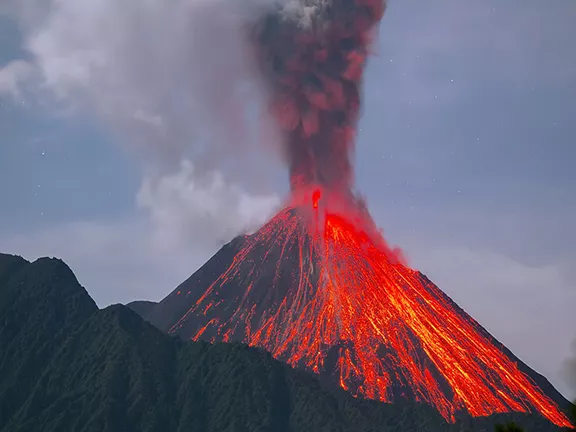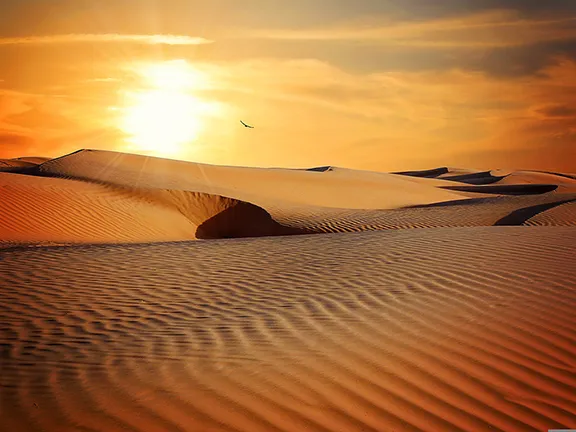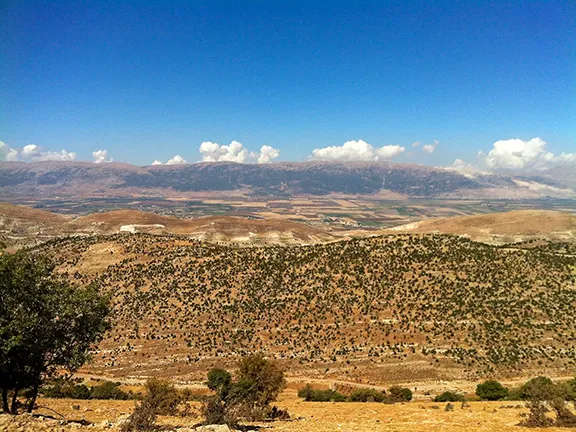Climatic Events that Changed the World
The 4.2k yr BP event
The 4.2kyr BP event was superimposed on the continuing drying phase initiated about 4000 BC caused by the southerly retreat of the summer monsoon and resulting in the desertification of the Sahara. Over southwest Asia, the drying trend of the last thousand years was punctuated by two spikes of aridity about 2200 BC.
By Nick Nutter on 2024-01-29 | Last Updated 2025-05-20 | Climatic Events that Changed the World
This article has been visited 7,927 times

What was the 4.2k yr BP climate event?
The 4.2k yr BP event, a severe aridification episode, occurred around 2200 BC, impacting regions across the globe. This event is characterized by a prolonged period of drought and reduced precipitation, particularly in subtropical and arid regions, including North Africa, the Middle East, the Indian subcontinent, and North America. The exact cause of the 4.2-kiloyear event remains debated, but it is hypothesized to be linked to a combination of factors, including changes in the North Atlantic Oscillation (NAO), a major atmospheric pattern influencing weather patterns across the Atlantic, and variations in solar activity. The event lasted some two or three hundred years before the climate returned to normal in the affected areas.
Do you enjoy my articles? For your reading pleasure, this website does not carry third party ads. You could help me write more articles by buying me a cup of coffee.
North Africa
By 2200 BC, the Sahara was a desert as we know it today. It was very sparsely occupied by ultra nomadic sheep and goat herders. Only two patches of landscape that could be called Mediterranean remained, the Maghreb and Cyrenaica on the north African coast. Between 3000 BC and 2000 BC, the people of the Maghreb had some contact with people in southern Spain as evidenced by lesser amounts of ivory and ostrich eggs turning up in Los Millares. In return they received a few Iberian objects, mainly tools, weapons, and decorated pots.
Looking east, the distance between the Nile and Cyrenaica proved too great and, by 2200 BC there appears to be no contact between the two. Closer to the Nile, early Egyptian records indicate that a tribe, the Tjehenu, who resided in what is now Libya, provided Egypt with mercenaries and a vegetable-based oil of uncertain provenance (not the olive). They apparently lived in settled communities. That being the case, they have not left any archaeological record of their presence.
Iberian Peninsula


Distribution of fortifed settlements (green) and ditched enclosures (red)
By the year 2200 BC, several societies had established themselves in the Iberian Peninsula such as the Los Millares society in the southwest and Vila Nova de Sao Pedro in Portuguese Estremadura. Most had nucleated during the long arid phase that followed the retreat south of the southern monsoon and the desertification of the Sahara Desert that started about 4000 BC.
Most famous were the copper age sites of the Los Millares culture in Almeria and Granada provinces in the increasingly arid southwest of the peninsula. In addition to the Los Millares sites, there are an estimated one hundred fortified copper age settlements in Iberia and a similar number of ditched enclosures. That is not counting the hundreds of small settlements with neither enclosure nor fortification. The ditched enclosures were concentrated on the best agricultural land, the Guadalquivir valley, and the Guadiana valley whilst the fortified settlements tended to occupy the more marginal land such as an ever increasingly arid Almeria.
One striking contrast between the societies in the west and those in the east is that the settlements in the west show no sign of a central 'palace' or elite residence.
Recent research indicates that, in the case of the Los Millares society, most of their settlements fell into disuse abruptly at 2200 BC. Within 10 or 20 years, the El Argar society were establishing themselves at La Bastida in Murcia, and in the Almanzora river valley in northeastern Almeria. By 1700 BC, they had expanded their territory from Granada in the west to Alicante in the east, and from Almeria on the coast to Ciudad Real in the Spanish Meseta. It is relevant to point out here that the El Argar society occupied what can best be described as marginal agricultural land, apart from the Almanzora valley. Perhaps their leaders had more idea how to cultivate and store crops in less favourable areas than their predecessors thus allowing a much more stratified regime to develop.
To the north of the El Argar group, in La Mancha, from about 2200 BC, the population there built motillas. These are fortified positions placed on top of man-made hills some four or five metres high. The structure included a well and some researchers are now looking at the possibility that the motillas were the first system of groundwater collection in the Iberian Peninsula. Although not built to be used as settlements, they were used to secure the water supply and process and store cereals on a large scale. Each of the twenty or so motillas overlooked and presumably controlled, an extensive area of agricultural land. It is possible, although nowhere proven, that they were also used as places of refuge, the most likely aggressors in times of shortages being the El Argar society to the south. The motillas remained in use for about one thousand years and were abandoned about the same time as the El Argar society collapsed.
Balearic Islands
The Balearic Islands have the distinction of being the last of the large Mediterranean islands to be inhabited. Opinions difer, but the original settling occurred somewhere between 2500 and 2100 BC. Most writers agree that the first inhabitants came from the northeast of the Iberian Peninsula and the adjoining area around the Gulf of Lion on the French coast between 2200 and 2100 BC. Were they looking for more agricultural land as a result of drying on the mainland? We shall never know.
The original settlers did not grow crops in the thin, rocky soil, but opted for a semi nomadic lifestyle with their sheep and goats and gathering wild plants to supplement their diet. Interestingly, they do not appear to have taken any advantage of the produce available from the coast and sea.
This is the period when the first dolmens were built on the islands and used for communal burials, a tradition presumably brought over from the mainland.
Sardinia
On Sardinia, soon after 2000 BC, a water cult evolved. Monuments were erected near sources of springs and wells that gave access to underground aquifers. The Megaron Temples were built during this period and there is no doubt that elaborate ceremonies took place in these temples. The concept and timing is similar to that adopted by the Motilla people on the Iberian Peninsula.
Egypt


Old Kingdom Egypt
In Egypt, the river Nile had provided a stable source of water to feed an ever-increasing population. Prior to 2200 BC, and specifically since 2700 BC, the kings of the Old Kingdom had overseen the development of a magnificent civilisation. This was the period when the great pyramids were built together with monumental statues of the kings and when the extent of territory controlled by Egypt extended from Libya in the west to Sinai in the east, from the Mediterranean in the north to Nubia in the south.
Egypt's trading partners, from as far afield as the Aegean and Anatolia in the northeast Mediterranean to Punt (modern day Eritrea), ensured a constant supply of luxurious and exotic goods not available in Egypt such as cedar wood, aromatic resins, ebony, myrrh and frankincense, gold, and copper. Much of this magnificence ended up in tombs and palaces, certainly the oppressed labourers, state owned craftsmen and the serfs that worked the palatial estates in the Nile delta saw little of this bounty.
This top heavy, autocratic system was in trouble before the 2200 BC event. A period of internal rivalries, and an overlong (at least in the opinion of his would-be successors who predeceased him), of Peppi II (2278 to 2184 BC) straddled the onset of the 2200 BC event. The power of the pharaoh gradually weakened in favour of powerful regional governors (nomarchs). These no longer belonged to the royal family and their charge became hereditary, thus creating local dynasties largely independent from the central authority of the Pharaoh. When, in some of the years following 2200 BC, the Nile failed to flood, resulting in famine, outright civil war erupted soon after the death of Peppi. The period following the Old Kingdom is known as the First Intermediate Period and one of its early nomarchs, Ankhtifi, on his tomb, sums up the desperate situation in Egypt at that time:
I gave bread to the hungry and clothing to the naked; I anointed those who had no cosmetic oil; I gave sandals to the barefooted; I gave a wife to him who had no wife. I took care of the towns of Hefat [i.e. el-Moalla] and Hor-mer in every [situation of crisis, when] the sky was clouded and the earth [was parched (?) and when everybody died] of hunger on this sandbank of Apophis. The south came with its people and the north with its children; they brought finest oil in exchange for the barley which was given to them.
The whole of Upper Egypt died of hunger and each individual had reached such a state of hunger that he ate his own children. But I refused to see anyone die of hunger and gave to the north grain of Upper Egypt. And I do not think that anything like this has been done by the provincial governors who came before me....I brought life to the provinces of Hierakonpolis and Edfu, Elephantine and Ombos!
Mesopotamia


Akkadian Empire
During the 24th century BC, the city states of Sumer; Eshnunna, Kish, Djemdet Nasr, Nippur, Isin, Shuruppak, Adab, Umma, Uruk, Girsu, Lagash, Larsa, Nina, Ur and Eridu, all between the rivers Euphrates and Tigris close to the head of the Persian Gulf, were conquered and loosely united by Sargon of Akkad. Sargon then moved northwest, staying within the bounds of the two rivers, into modern day Iraq, Syria, and southern Turkey (known as Anatolia). The empire he created is known as the Akkadian Empire.
The empire was dependent on irrigation-based agriculture in the south and rain fed agriculture in the north. Under Sargon and his successors, agricultural production increased until some of the city states had the highest population density in the then known world. The surplus produce was used in trade to obtain everything else the region lacked including metal ores, timber and building stone. These essentials plus exotic goods came from the Levant, Anatolia, and places as far distant as Egypt and the Indus valley.
Recent research at one of the Akkadian imperial cities, Tel Leilan in the far northeast of Syria, may give us a clue as to what happened around the year 2200 BC in the northern parts of the empire.
It seems as though a three-hundred-year long drought started about 2200 BC. Tel Leilan was largely abandoned. Archaeological evidence shows that skeleton-thin sheep and cattle died of drought, and up to 28,000 people abandoned the site, presumably seeking wetter areas elsewhere. Another population centre, Tell Brak, shrank in size by 75%.
Pastoralists from the Levant, known as Amorites, took advantage of the decline in control exerted by the Akkadian Empire and started to drift into the area.
Meanwhile, to the south, water levels within the Tigris and Euphrates fell 1.5 metres beneath the level of 2600 BC, and although they stabilized for a time, rivalries between pastoralists and farmers increased. Attempts were undertaken to prevent the former from herding their flocks in agricultural lands, such as the building of a 180-kilometre-long wall known as the "Repeller of the Amorites" between the Tigris and Euphrates. There is also some indication that the salt levels in the soil of the irrigated fields increased during this period, further reducing crops.
The Akkadian Empire had effectively dissolved by 2150 BC and eventually the Amorites expanded throughout the region and beyond and by 2000 BC, ruled most of the Levant, Mesopotamia, and part of Egypt.
In 2019, researchers undertook a DNA analysis of bronze age cattle from the Fertile Crescent, specifically from the wild Bos indicus (better known as the zebu) and the domesticated Bos taurus. Domesticated Bos taurus and the zebu Bos indicus lived separately for thousands of years. However, the team's results suggest that, quite suddenly around 4,200 years ago, zebu bulls began to breed with Bos taurus right across the Fertile Crescent. Farmers were making a deliberate choice to allow breeding with the arid-adapted zebu to safeguard their herds in the face of climatic changes.
The Levant


Byblos survived
In the Levant, at this time, Ugarit was abandoned, as were Sidon and Tyre although Byblos and a few other towns centred on the few springs that survived the desiccation, for example Tell Iktanu in the Jordan valley, survived in a reduced form. In the southern Levant, estimates of population decline vary between 80 and 90%, truly catastrophic, and a situation that the Amorite pastoralists were not slow to take advantage of.
Greece, Cyclades, Malta, and Crete


House of Tiles, southern Greece
Archaeological evidence indicates that, around 2200 BC, the so called 'Great Houses' of southern Greece, and the maritime trading circuit around the Cyclades, together with many of the settlements on the mainland and islands ended. The 'House of Tiles' in southern Greece is probably the most famous of the 'Great Houses'. It was destroyed in the 22nd century BC. Similarly, the 'Temple Phase' on Malta faded, although this may have begun some two hundred years earlier.
On Crete, the settlement at Knossos protected itself with a massive wall, built about 2200 BC. Over the following two hundred years Knossos grew to become one of the largest communities in the Mediterranean. The first palaces were constructed after 1950 BC. Interestingly, from about 2000 BC, Cretan seals started to depict the first sailing ships in the Aegean.
Conclusions
This section should really be headed 'Winners and Losers,' for, although the 4.2k yr BP event clearly did affect huge areas and large numbers of people, its affect was patchy and human reaction different across the Mediterranean basin. For some, the event provided opportunity.
The Amorite pastoralists of the Levant, who had previously been confined to the dryer, more steppe like margins, saw an opportunity with the decline of the Akkadian Empire and eventually established their own empire. Not as obvious, the 'winners' of the collapse of the Old Kingdom in Egypt, were the serfs, unpaid labourers and craftsmen who were suddenly released from toiling on monuments and, until central control was re-established some 125 years later under Mentuhotep II, free from pharaonic taxes.
The period 3500 BC to 2200 BC is sometimes referred to as 'the long third millennium'. What is remarkable about this period is the incredible advances made by societies and civilisations the length and breadth of the Mediterranean, apart from in desertified North Africa. It has been suggested that populations around the Mediterranean basin doubled from 5 to 10 million people. The first large scale societies expanded in Egypt and Mesopotamia and monumental, even megalithic buildings appeared.
The wheel was first used to throw pots about 4200 BC in Mesopotamia and by 3500 BC was being used on vehicles.
Animals were bred for their secondary products. Current evidence suggests not simple diffusion from a centre of origin or a single horizon of change, but more piecemeal adoption according to local conditions. Mortality profiles indicate dairy use by about 6000 BC in northern Italy (sheep and goats), 5800 BC in western Iran (sheep and goats), and 5500 BC in Greece (sheep). The earliest artistic depiction of milking is on a Sumerian cylinder seal from c. 3300 BC, probably well after the inception of dairy use in the Near East. Ceramic sieves from the Early Neolithic Linear Pottery culture of central Europe (c. 5500 BC) may have been used in cheese making, a practice that rapidly spread around the Mediterranean.
Studies applied to faunal remains of the northern Balkans have suggested the use of cattle in traction (probably ploughing) in the Late Neolithic, c. 4500 BC. Wheeled vehicles, slow, four-wheeled carts, apparently drawn by cattle, seem to have spread even faster than the use of cattle drawn ploughs. On current evidence, they appeared at about the same time in Europe and the Near East, c. 3500 BC.
By 4000 BC, the full repertoire of vegetables and fruits were being grown around the Mediterranean basin including the cultivated olive that appeared about 5000 BC, whose oil and fruits would soon after become a valuable commercial product. Seals, an invaluable accessory to the merchant trader, were first used about 3500 BC in Mesopotamia.
Copper smelting is thought to have started in Egypt about 5000 BC, and Iran and Anatolia by 4000 BC, whilst the smelting of gold has an even longer history, from about 6000 BC in Mesopotamia.
Knowledge gained prior to the start of the Sahara drying event and subsequent stresses placed on the societies that existed then, was not lost. It was carried into the surviving population and provided a kick start for the new wave of societal development that took place between 3500 BC and the climatic event looked at in this article, about 2200 BC.
References:
Broodbank, C. (2013) The Making of the Middle Sea. Thames and Hudson, London.
Daniel M- Fernandes et. al. 'The spread of steppe and Iranian-related ancestry in the islands of the western Mediterranean', Nature Ecology and Evolution (2020). DOI: https://doi.org/10.1038/s41559-020-1102-0
Risch, Roberto & Lull, Vicente & Mica, Rafael & Rihuete, Cristina. (2015). Transitions and conflict at the end of the 3rd millennium BC in south Iberia. 10.13140/RG.2.1.3881.1286.
Zanchetta, G., et al. (2015). The 4.2 ka BP aridity event in the eastern Mediterranean: A review of paleoclimate records and their implications for human societies. Quaternary Science Reviews, 123, 117-138.
Weiss, R. F., et al. (2016). A review of the 4.2 ka challenge: Lessons from paleoclimate reconstructions for understanding contemporary climate change. Earth-Science Reviews, 161, 1-29.
Global distribution of the 4.2 kiloyear event map by Jianjun Wang, Liguang Sun, Liqi Chen, Libin Xu, Yuhong Wang & Xinming Wang - The abrupt climate change near 4,400 yr BP on the cultural transition in Yuchisi, China and its global linkage. Material provided under a Creative Commons 4.0 license: This article is licensed under a Creative Commons Attribution 4.0 International License, which permits use, sharing, adaptation, distribution and reproduction in any medium or format, as long as you give appropriate credit to the original author(s) and the source, provide a link to the Creative Commons license, and indicate if changes were made.", CC BY-SA 4.0, https://commons.wikimedia.org/w/index.php?curid=79003517
Do you enjoy my articles? For your reading pleasure, this website does not carry third party ads. You could help me write more articles by buying me a cup of coffee.
 1: Climatic Events
1: Climatic Events 2: The 8.2k yr BP event
2: The 8.2k yr BP event 3: Creating the Sahara
3: Creating the Sahara 5: The 3.2k yr BP Event
5: The 3.2k yr BP Event